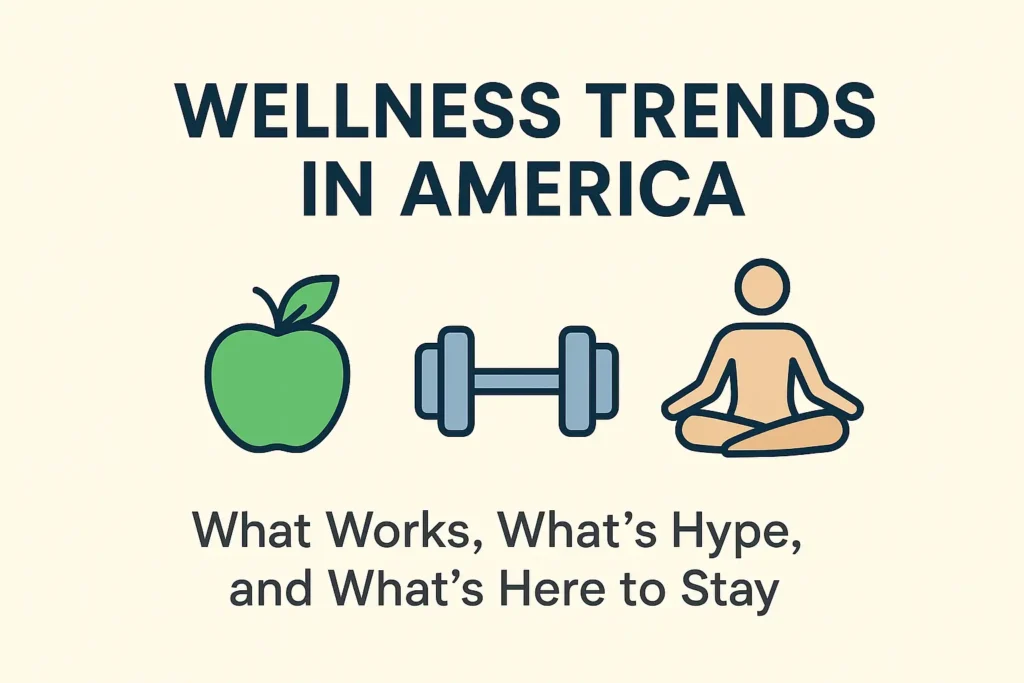The last two years the wellness industry in America market boom into a trillion-dollar market not only affecting the US, but shaping lifestyle on the global stage. From functional foods and biohacking to boutique fitness studios and mindfulness apps, wellness has evolved from a mystical niche to a social movement. ByFrom biohacking and functional foods to mindfulness apps and boutique fitness studios, wellness has been transformed from a mystical niche to a social movement. Through all the innovation, marketing approach, and disinformation, one question rises above the rest: hype or do these wellness trends work?
Here at techbizpinnacle, we’re where technology, business, and culture overlap — and well-being is the largest overlap of our time. On this website, we sort through the most compelling wellness trends in America, weigh what’s worth spending cash on, and figure out what will stay with us in 2025 and beyond.
The Growing Wellness Economy in the US.
US-American well-being economy is more than $1.5 trillion worldwide (McKinsey and Global Wellness Institute reports), with the US having a significant part in this. Well-being is no longer exclusive to spas or the gym; it has pervaded as the attribute of close to every enterprise, from wearables to takeaways.
Drivers are:
l Tech adoption: Wearables, health apps, AI-diagnosis.
l Consumer health need for prevention: Post-pandemic has underscored longevity and immunity.
l Social influence: Wellness influencers, Instagram, and TikTok leading micro-trends.
l Corporate wellness: Corporates investing in employees’ well-being to boost productivity.
But where there is demand, there is oversaturation, and not all trends are created equal. Let us keep science-backed practices aside from fleeting fads.
What Works: Science and Lifestyle Changes
1. Personalized Nutrition & Functional Foods
From DNA-diet apps to gut health supplements, diet personalization is going mainstream. Americans are spending on:
l Probiotics & prebiotics for healthy guts.
l Plant-based protein powders on the rise.
l Adaptogens such as ashwagandha that soothe stress.
The trend becomes so popular because it is founded on biological diversity — an awareness that there is not one diet for the masses. Technology (apps fueled by AI, test kits for the microbiome) is fueling the trend.
2. Wearable Wellness Tech
The wearables monitor:
l Heart rate variability (HRV).
l Sleep score.
l Blood oxygen saturation.
l Stress indicators.
Wearables provide actionable feedback, thus the reason they are not a fleeting trend. AI-powered health coaching guarantees the trend will increase in everyday life.
3. Mental Health & Mindfulness Apps
Mental health conversation sped up during the pandemic, and their platforms such as Headspace, Calm, and BetterHelp were the talk. Mindfulness, meditation, and counseling apps have evidence of lower stress levels and increased resilience.
No hype — internet solutions for mental health are here to stay, as more and more companies make subscription a part of company packages.
4. Strength Training Instead of Cardio Madness
In America, in the past, running and cycling were the fitness. Today, though, strength training is the king of fitness. From women weightlifters to men adopting functional strength training, it is shaping body ideals and health results.
Science confirms that strength training builds longevity, prevents disease, and fuels metabolism — something that won’t wither away.
5. Preventive Health and Longevity
Biohacking — cryotherapy to NAD+ IV drips — sounds radical, but the aging movement does have science in its corner. Americans increasingly are asking for preventive, not reactive, care. Baseline blood tests, wearables, and tailored supplementation are making medical care “self-care.”
What’s Hype: Trends That Don’t Live Up to the Buzz
Not all wellness trends are here to stay. Some are championed by marketing and have little science behind them.
1. Radical Detox Diets & Juice Cleanses
Detox diets appear wonderful on Instagram, but scientifically speaking, your kidneys and liver detoxify your body quite nicely as it stands. Juice cleanses in the long term lead to lack of nutrients. Short-term combinations of juices are alright, but to employ them as magic bullets is hype.
2. Crystal Healing & Energy Vibes
There’s room for spiritual health, but no scientifically-verified proof that crystals “treat” illness. Crystals are calming and do possess mindfulness value, but they’re not substituting evidence-based treatment.
3. Ridiculously-priced “Superfood” Powders
From kale powder to $60 packets of collagen peptides, not all superfoods are created equal. Whole foods do the same thing without all that expense. Collagen and greens powders can be incorporated into diets, but they’re more marketing magic than they are necessary.
4. Infrared Saunas: A Cure-All
Infrared saunas do raise circulation and relaxation, but to refer to them as the secret to weight loss, chronic disease, or detox is premature. Helpful for rehab, but not magic.
5. Hyped-Up Fitness Gimmicks
As wearables have succeeded, most expert fitness gadgets (smart dumbbells, vibration plates) are tech tricks, not innovations. Strength, cardio, recovery — the fundamentals — remain more effective than tech tricks.
What’s Here to Stay: Trends in American Wellness

In addition to trends, there are certain wellness habits that are becoming cultural norms that endure:
1. Merging Holistic Healthcare
American medicine is gradually merging with wellness. Doctors more and more write script for lifestyle change, nutrition, and stress reduction as frequently as they do medication. Preventive health plans will become the norm.
2. Workplace Wellness Programs
From virtual yoga sessions to mental health allowances, US firms are embracing wellness initiatives to hold onto staff in the workplace. With hybrid work and remote work, virtual wellness platforms will be in the spotlight.
3. Hybrid Fitness Models
Peloton and home workout app pandemic surge continues unabated. Americans increasingly combine in-home virtual fitness and in-gym exercise for convenience.
4. Sustainability in Wellness
The conscious consumer wants sustainable goods — from water bottles to responsibly harvested supplements. Sustainability is a long-term perspective to guide purchase behavior.
5. Nutrition + Tech Mashup
Genetic testing, microbiome testing, and AI-driven health coaching are ushering in a mashup age of nutrition and tech. Infrastructure, science, and consumer demand are driving the trend.
UK Perspective: Why American Wellness Trends Matter Globally
From London to Manchester, British consumers have the tendency to hop on the health bandwagon once created in America. Some of them are:
l The kombucha and vegan diet trend.
l Mindfulness apps first becoming the rage in America before entering into fashion in the UK.
l Wearables spearheading the global fitness trend.
To the British reader, keeping up with American trends on well-being is more than a question of intellectual interest — it is a key to Britain’s future for its health clubs, food stores, and medical care.
Final Thought
The American wellness industry is a fascinating mix of evidence-based innovation and marketing insanity. There are trends — like weight training, meditation programs, and personal dieting — that really are transforming individuals’ lives, and there are others — like juice cleansing or costly powders — that are extremely dependent on marketing and lack a quantifiable result.
For companies and individuals, the solution is to distinguish between trends and evidence and pragmatism. TechBiz’s perspective is that future wellness is integration — technology, well-being, sustainability, and human connection. That is the way that will take America to wellness as well as lay the groundwork for global wellness in the decades ahead.
FAQs: Wellness Trends in America
Q1: What is the fastest growing wellness trend in America today?
Wearable health tech and tailored nutrition are the two most rapidly expanding, since consumers are eager for fact-based knowledge concerning their health.
Q2: Are juice cleanses and detox diets worth it?
No. They will deliver in the short term, yet your body automatically detoxifies. Healthy living by healthy eating is a much more plausible option.
Q3: Why does America copy UK wellness trends?
The U.S. leads global wellness markets in new product tone setting, media, and influencer. UK consumers and businesses will adopt such trends once they have been proven to work.
Q4: Which of the trends are likely to remain?
Mobile mindfulness apps, strength training, office wellness, and nutrition with technology will remain.
Q5: How do you recognize hype in wellness marketing?
Look for scientific evidence. If something is generating hyperbolic statements without evidence to back them up, then it’s hype.

